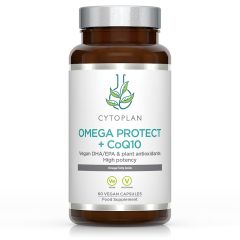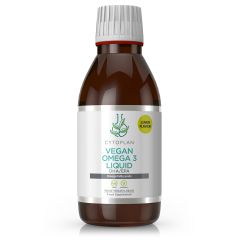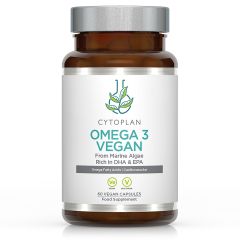Can I get enough omega 3 from diet?
There are three major types of omega-3 fatty acids that we can get through our diets: alpha-linolenic acid (ALA), eicosapentaenoic acid (EPA) and docosahexaenoic acid (DHA). EPA and DHA play an essential role in the function of our cell membranes and provide the starting point for hormones that regulate the relaxation and contraction of artery walls, inflammation and blood clotting. Research shows that omega-3 fatty acids contribute to a reduction in inflammation and can therefore help to lower the risk of chronic disease such as arthritis and cardiovascular disease. Symptoms of a deficiency of omega-3 fatty acids include fatigue, poor memory and concentration, low mood, poor circulation and dry skin.
ALA is an essential fatty acid, which means it cannot be made naturally in the body, and therefore we must obtain it from the diet, where it is found mainly in rapeseed and linseed oils (flaxseed), sunflower, chia and pumpkin seeds, nuts (walnuts, pecans and hazelnuts) and green leafy vegetables. Oils should always be cold pressed and unrefined to protect the fatty acids during the extraction process as well as preserve the other naturally occurring nutrients.
ALA from food can be converted by the body into EPA and DHA – but this process is not always effective; in fact, the conversion rate is estimated at only around 5%-8%. When we also bear in mind that ALA and omega 6 fatty acids are metabolised by the same pathway, the high level of omega 6 present in the modern western diet (from foods such as sunflower and corn oils and processed foods) can competitively interfere with the conversion of ALA to EPA and DHA – suggesting a need for dietary sources of EPA and DHA to prevent deficiency.
The long chain fatty acids EPA and DHA are mainly found in cold-water oily fish such as salmon, sardines, halibut and mackerel. The NHS recommends eating at least 1 portion of oily fish (around 140g) per week but that pre-menopausal women, and especially those who are pregnant or breastfeeding should consume no more than 2 portions weekly. This is because of the concern about contamination of fish with heavy metals, PCBs and other pollutants. With this in mind, it is best to choose smaller fish such as wild salmon and sardines; avoiding larger fish such as fresh tuna and swordfish (tinned tuna isn’t considered an oily fish as the oils are mostly lost through the cooking process prior to canning). The source of the oily fish is important to consider, with a recent investigation showing that farmed Alaskan salmon only provided 1/3 of the amount of EPA and DHA of that of wild salmon.
So, while it is possible for much of the population to obtain sufficient omega-3 through diet, it is important to consider the source of the fatty acids, and certain population groups such as vegans and vegetarians could benefit from taking an omega 3 supplement from algae in order to achieve adequate levels of EPA and DHA. In pregnancy and breastfeeding it also may be prudent to take an omega 3 supplement, partly because of the risk of contaminants in oily fish to the health of the baby, and partly because of the essential role of DHA in the development of the baby’s retina and brain cells. Finally, those with certain health conditions could benefit from supplementing with therapeutic levels of EPA and DHA, including cardiovascular disease, depression, psychiatric and behavioural disorders, cognitive decline and inflammatory conditions.
Please note that there are contraindications between omega 3 supplements and some medications, so it is always worth checking with a medical professional or our team of nutritional therapists on nutrition@cytoplan.co.uk in the first instance.










